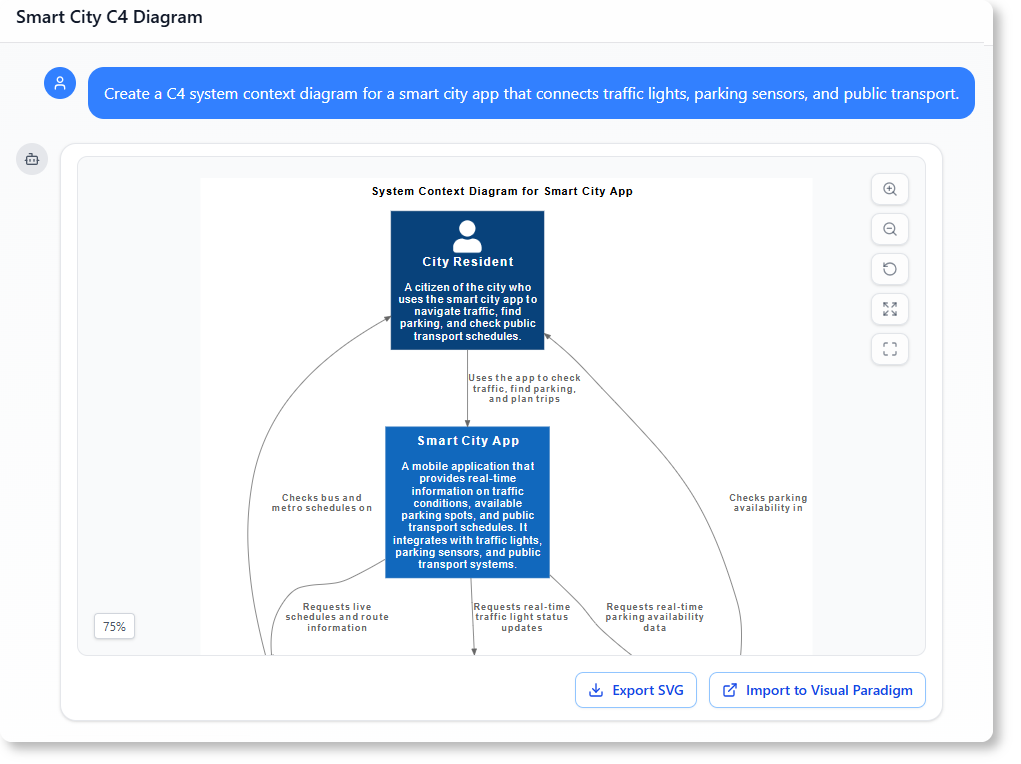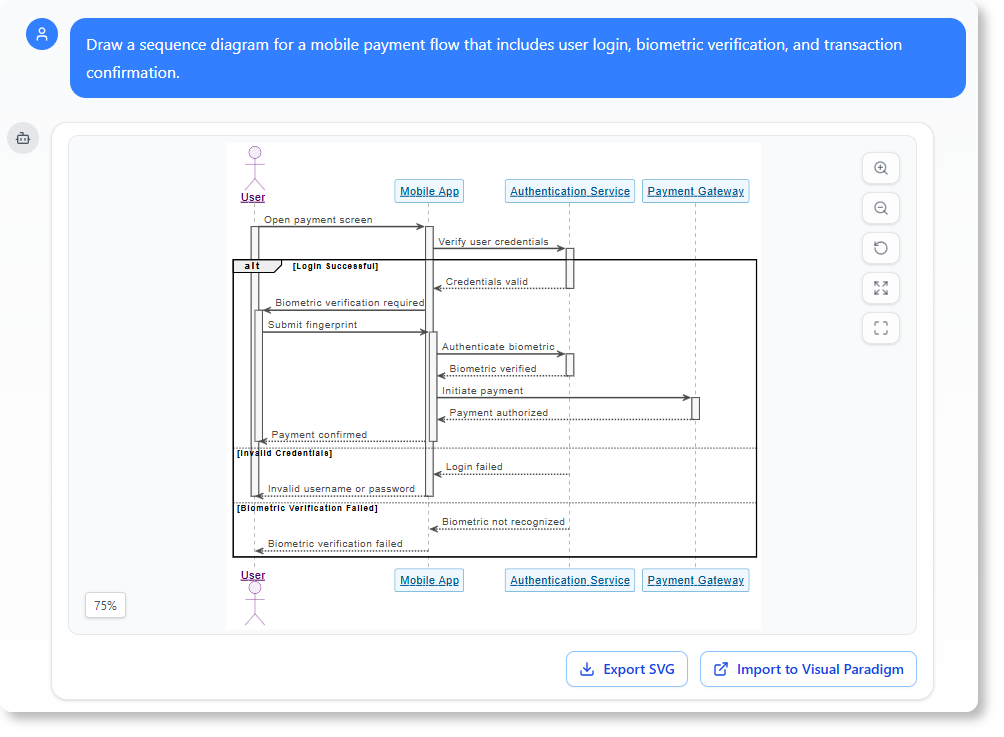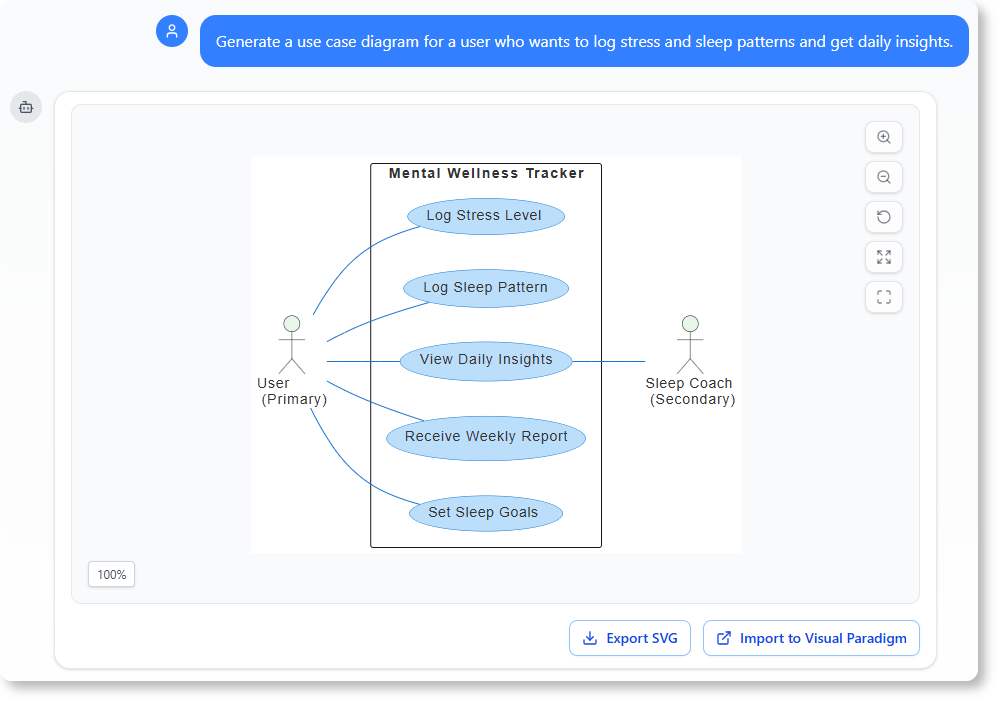Why Starting a Business Without a Clear Model Is Like Building a House Without Blueprints
When launching a new product, you know your customers care about sustainability, but you’re not sure how to map out the features they want. You’ve got a team, but no shared understanding of how the system works. That’s where AI tools come in—not as a shortcut, but as a co-pilot for creativity and clarity.
The visual paradigm ai chatbot changes the game by turning vague ideas into professional diagrams with just a few sentences. Instead of digging through spreadsheets or sketching on a napkin, you describe your vision, and the system generates a clear, structured model. This isn’t just about making diagrams—it’s about making decisions faster, testing ideas earlier, and building shared understanding from the start.
What if your entire workflow could respond to a simple question like “Generate a SWOT analysis for a sustainable fashion brand targeting urban millennials”? The AI doesn’t just produce a list—it builds a structured framework with actionable insights. That’s the power of ai-powered diagramming: translating thoughts into visual clarity.
How the Visual Paradigm AI Chatbot Turns Ideas into Action
The real magic happens when you stop thinking of modeling as a technical task and start seeing it as a form of communication.
With the ai chatbot for modeling, you don’t need prior knowledge of UML, ArchiMate, or SysML. You speak in plain language, and the tool responds with a tailored diagram. Whether it’s a use case diagram for a mobile app, a deployment structure for a cloud service, or a marketing mix model for a startup, the AI understands context and intent.
For example:
“Create a C4 system context diagram for a smart city app that connects traffic lights, parking sensors, and public transport.”

The chatbot generates a clean, professional C4 diagram in seconds—showing the app as a central node, connected to infrastructure like traffic signals and parking bays. You can then refine it by asking:
“Add a user role for city planners and show how they interact with the system.”
This level of natural language diagram generation removes the barrier between imagination and execution. It’s not about memorizing standards—it’s about applying them when you need them.
This is especially powerful in early-stage product development or business strategy, where teams are still aligning on goals. The AI helps surface hidden assumptions, reveals missing connections, and turns messy conversations into structured models.
When to Use the Visual Paradigm AI Chatbot
The right moment to use the AI chatbot isn’t when you’re stuck—it’s when you’re thinking.
Use it when:
- You’re brainstorming a new product and need to map out user flows or system interactions.
- Your team lacks a shared understanding of how a process works.
- You want to compare different business strategies quickly—like PEST, SWOT, or Ansoff Matrix.
- You’re evaluating a technology solution and need to visualize its architecture.
For instance, a fintech founder might say:
“Draw a sequence diagram for a mobile payment flow that includes user login, biometric verification, and transaction confirmation.”

The AI delivers a clear, accurate sequence diagram. It doesn’t guess—it interprets the flow based on real-world patterns and modeling standards. This kind of generate diagrams from text capability is not just helpful—it’s essential for innovation teams moving fast.
The chatbot doesn’t just respond. It suggests next steps. After generating a deployment diagram, it might ask:
“Would you like to explain how the microservices communicate?”
“Or explore the risks of a single point of failure here?”
These follow-ups keep the conversation going, helping you explore deeper layers of a system.
Why This Kind of AI-Powered Modeling is a Game-Changer for Designers and Innovators
Traditional modeling tools were built for experts. They required training, specific syntax, and deep familiarity with standards. The ai chatbot for software modeling flips that model.
It treats modeling as a language—one that anyone can learn through practice and context. The AI learns from thousands of real-world diagrams and modeling standards, so it can help you create:
- UML use case and activity diagrams
- SysML requirement and block definition diagrams
- Enterprise architecture views in ArchiMate
- Business frameworks like the McKinsey 7S or Blue Ocean Four Actions

Each diagram is grounded in established practices, yet generated through natural conversation. You’re not just creating a drawing—you’re building a shared mental model.
This is especially powerful in cross-functional teams. A product manager can describe a feature, and the AI generates a diagram that the engineers can understand. A sales leader can explain a customer journey, and the AI turns it into a visual flow that the support team can use.
It’s not magic. It’s intelligence applied to the way we work.
From Idea to Insight: A Real-World Scenario
Meet Lila, a founder of a health and wellness app. She wanted to launch a platform that helps users track sleep and stress, but she didn’t know how to structure the features or user journeys.
Instead of jumping into wireframes or spreadsheets, she opened the visual paradigm ai chatbot and said:
“Generate a use case diagram for a user who wants to log stress and sleep patterns and get daily insights.”

The AI produced a clear use case diagram with actors like “User,” “App,” and “Insight Engine,” showing how the user logs data, receives reports, and sets goals.
She then asked:
“Can I add a feature where the app recommends breathing exercises based on stress levels?”
The chatbot updated the diagram and added a new use case. Lila shared the result with her team. Within minutes, they had a shared understanding of the app’s core functionality—and a path forward.
This wasn’t just modeling. It was creative problem-solving made visible.
How the Tool Fits Into Your Workflow
The visual paradigm ai chatbot isn’t a standalone feature. It’s a starting point.
You can use it during:
- Early ideation to explore ideas quickly
- Team alignment to show how systems or users interact
- Strategy sessions to compare business models
- Documentation to generate clear visual summaries
And every session is saved. You can revisit past chats, share the URL with a colleague, or use the same conversation as a reference for future work.
Because the AI remembers what you’ve discussed and suggests follow-up questions, it becomes a thinking partner—not just a tool.
Frequently Asked Questions
Q: Can the visual paradigm ai chatbot handle complex systems like enterprise architecture?
Yes. It supports ArchiMate with over 20 viewpoints, enabling you to model business and technical relationships at scale.
Q: Does the AI understand business frameworks like the SWOT or PEST?
Absolutely. It can generate SWOT, PEST, PESTLE, and other business models from natural language input, making strategic analysis intuitive.
Q: Can I generate a diagram for something I haven’t seen before?
Yes. The AI uses training in modeling standards to build accurate diagrams even for novel concepts, as long as you describe them clearly.
Q: Is the AI capable of refining diagrams after they’re created?
Yes. You can request changes—adding or removing elements, renaming components, or adjusting relationships—through natural language.
Q: Can I use this for non-technical teams?
Perfectly. The AI understands non-technical language and translates it into professional diagrams without requiring domain knowledge.
Q: How does the AI ensure accuracy and alignment with standards?
It’s trained on real-world modeling standards, so every diagram follows established conventions and maintains consistency across types.
Where to Find Your AI Chatbot: Desktop vs. Online
We’re thrilled about the new AI Chatbot, but we know our product structure can sometimes cause confusion. The AI Chatbot is technically a feature of Visual Paradigm Online (VP Online).
The Integrated Advantage
When you own a Visual Paradigm Desktop license with active maintenance, you’re granted access to several powerful VP Online features. In particular, if you have the Professional or Enterprise Edition license, you can use the AI Chatbot inside the desktop environment.
- Unified Account: You maintain one account, and your workspace is shared across both platforms. No data transfer is needed.
- Dual Access: Use the chatbot directly inside your Desktop application or from any web browser via Visual Paradigm Online.
Ready to Experience the AI Chatbot?
Try It Now (No Sign-Up Required)
Want a quick demo? Click the link below to start using the AI Chatbot instantly with limited functionality. Experience the power of diagram generation and analysis immediately.
Get Full Access & Seamless Integration
Full access includes persistent chat history and the ability to import generated diagrams directly into VP Desktop for advanced modeling.
For Existing Visual Paradigm Desktop (Professional/Enterprise) Users:
Since you already hold a qualifying license, you do not need to purchase Visual Paradigm Online.
- Sign up for a FREE Visual Paradigm Online account.
- Log in with your new VP Online credentials from within your Desktop application.
For Users Who Don’t Yet Own a Desktop License:
To unlock the full integration features (including diagram import), you will first need a Visual Paradigm Desktop Professional Edition license (or Enterprise for ArchiMate).
Once you purchase your Desktop license, simply follow the steps above for existing users: Sign up for your FREE VP Online account and log in through the Desktop application.
Note on Desktop Import: The import feature for generated diagrams (UML, ArchiMate, etc.) requires a Professional Edition license or higher. Importing ArchiMate diagrams specifically requires the Enterprise Edition license.

